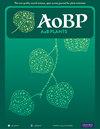水稻生长早期低温反应的遗传:一个耐受的隐性基因和驯化的重要性
IF 2.6
3区 生物学
Q2 ECOLOGY
引用次数: 0
摘要
摘要水稻的低温适应性是由基因型耐受低温的能力介导的。对水稻胚芽期耐冷性的一个遗传位点进行了分析。日本地方粳稻品种A58的耐受性等位基因为隐性遗传基因(ctp-1A58),而野生稻品种Ctp-1W107和现代品种Ctp-1HY的易感等位基因为显性遗传基因。在热带粳稻品种(Silewah)中发现了另一个隐性耐药等位基因ctp-1Silewah。精细定位显示,ctp-1位点的候选基因编码一种类似于核苷酸结合域和富亮氨酸重复(NLR)蛋白的蛋白质,其中73 bp缺失的移码突变可能赋予ctp-1A58的低温耐受性。近等基因系分析表明,ctp-1A58只在0.5°C和2°C的低温下具有耐受性,无论是在胚芽期还是幼苗期。低温驯化(8℃~ 16℃)72 h后,Ctp-1W107和Ctp-1HY的易感表型被掩盖。此外,在8°C下进行12 h的短期驯化处理足以使其完全驯化。这些结果表明,NLR基因在低温胁迫下诱导易感反应,而另一个与驯化反应相互作用的基因可以抑制Ctp-1等位基因引起的不适应表型。该研究为水稻在低温环境下的适应和育种提供了新的思路。本文章由计算机程序翻译,如有差异,请以英文原文为准。
Genetics of chilling response at early growth stage in rice: A recessive gene for tolerance and importance of acclimation
Abstract Low-temperature adaptation in rice is mediated by the ability of a genotype to tolerate chilling temperatures. A genetic locus on chromosome 11 was analyzed for chilling tolerance at the plumule stage in rice. The tolerant allele of A58, a japonica landrace in Japan, was inherited as a recessive gene (ctp-1A58), whereas the susceptible alleles from wild rice (Ctp-1W107) and modern variety (Ctp-1HY) were the dominant genes. Another recessive tolerant allele (ctp-1Silewah) was found in a tropical japonica variety (Silewah). Fine-mapping revealed that a candidate gene for the ctp-1 locus encoded a protein similar to the nucleotide-binding domain and leucine-rich repeat (NLR) protein, in which frameshift mutation by a 73 bp-deletion might confer chilling tolerance in ctp-1A58. Analysis of near isogenic lines demonstrated that ctp-1A58 imparted tolerance effects only at severe chilling temperatures of 0.5 °C and 2 °C, both at plumule and seedling stages. Chilling acclimation treatments at wide range of temperatures (8 °C–16 °C) for 72 h concealed the susceptible phenotype of Ctp-1W107 and Ctp-1HY. Furthermore, short-term acclimation treatment of 12 h at 8 °C was enough to be fully acclimated. These results suggest that the NLR gene induces susceptible response upon exposure to severe chilling stress, however, another interacting gene(s) for acclimation response could suppress the maladaptive phenotype caused by the Ctp-1 allele. This study provides new insights for adaptation and breeding of rice in a low-temperature environment.
求助全文
通过发布文献求助,成功后即可免费获取论文全文。
去求助
来源期刊

AoB Plants
PLANT SCIENCES-
CiteScore
4.80
自引率
0.00%
发文量
54
审稿时长
20 weeks
期刊介绍:
AoB PLANTS is an open-access, online journal that has been publishing peer-reviewed articles since 2010, with an emphasis on all aspects of environmental and evolutionary plant biology. Published by Oxford University Press, this journal is dedicated to rapid publication of research articles, reviews, commentaries and short communications. The taxonomic scope of the journal spans the full gamut of vascular and non-vascular plants, as well as other taxa that impact these organisms. AoB PLANTS provides a fast-track pathway for publishing high-quality research in an open-access environment, where papers are available online to anyone, anywhere free of charge.
 求助内容:
求助内容: 应助结果提醒方式:
应助结果提醒方式:


